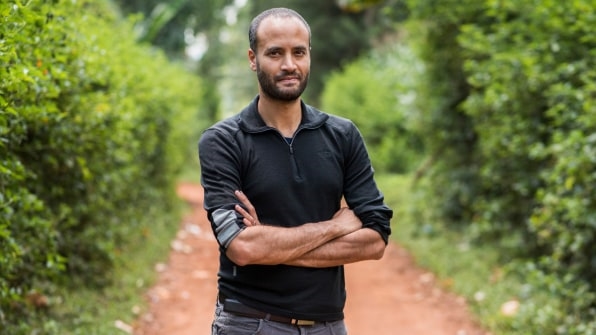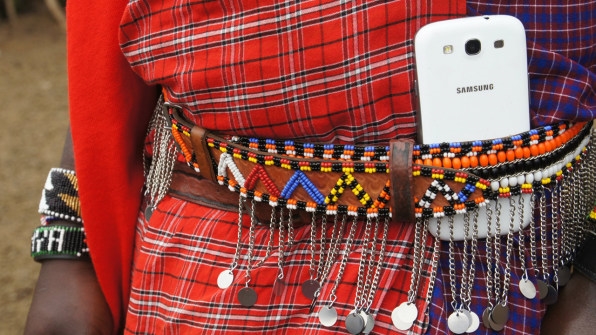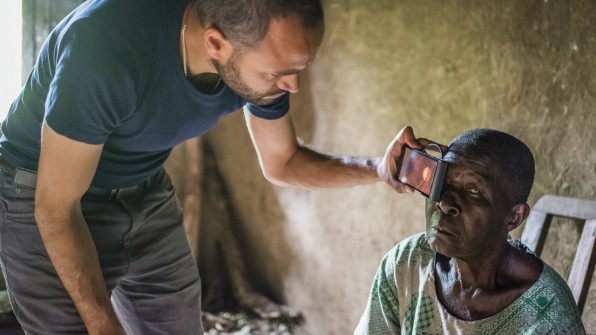In mid-March, Dr. Andrew Bastawrous, a British-Egyptian ophthalmologist now based in Kenya, took the podium in Westminster Abbey to address the 53 world leaders gathered there for Commonwealth Day, an annual convening of the former territories of the British Empire. He was a bit nervous, he tells Fast Company–previous Commonwealth Day reflection speakers included Malala Yousafzai and Kofi Annan, and their talks generally swept across wide-scale, difficult-to-solve topics like eradicating climate change and bringing about gender equity.
Bastawrous took a different approach. “I was talking about something particular, but something that we can definitely solve,” he says. That thing is blindness and visual impairment. He told the leaders gathered that 85 million people across the Commonwealth are blind or poorly sighted (the number globally is 2.5 billion), and four in five of those people suffer from causes that are treatable. His social enterprise, Peek Vision, which he set up in Kenya in 2012, aims to eradicate curable blindness, and with a new $1 billion Vision Catalyst Fund established with the support of leading eye health organizations and banks, which Bastawrous announced during his Commonwealth speech, it’s much closer to doing so.

“I’m deeply troubled that literally billions of people can’t see clearly, many for the want of something as simple as a pair of glasses, or a low-cost surgical procedure,” says Bastawrous, who is also a TED senior fellow. It was that frustration, coupled with his own experience of growing up visually impaired and understanding firsthand how glasses changed his ability to function productively in the world, that inspired him to launch Peek.
When Bastawrous first moved to Kenya in 2012 with his family, he planned to set up 100 eye clinics to treat patients across the country who lacked access to eye exams, glasses, and surgeries. He wanted to “better understand the eye health needs of the population and provide a service at the same time,” he says. But it soon became clear to Bastawrous that the clinics were limited in their ability to help people–the bulky equipment was difficult to transport, and there were far more people in need, he realized, than the clinics could accommodate.
Bastawrous and his team decided then to develop a simple smartphone app-based eye exam, Peek Acuity, which contains an interactive vision test, as well as Peek Retina–a clip-on smartphone extension that lines up with the phone’s camera, and allows health workers to look into the back of a patient’s retina (on Bastawrous’ phone, when he demonstrated the extension, the image shows a network of veins and nerves at the back of the eye which connect to the brain, and are often the site of disease or disruptions that cause vision problems).

Because the app and the attachment are so easy to use, Peek has trained and equipped parents and teachers to use the tools and screen their students and others. “Smartphone usage is rising all the time in low- and middle-income countries –in some regions, more people have mobile phones than access to clean water,” Bastawrous says. “The app is designed to work on inexpensive Android phones, so you can make use of a device which many people will already have in their pocket for vision screening.” The app also includes a vision simulator that shows how real-world scenes captured through the smartphone’s camera appear to someone with a certain degree of visual impairment. Peek’s school screening program has tested over 100,000 kids in Kenya, India, and Botswana.
In October 2017, Botswana announced that it will, through a partnership with Peek Vision and funding from the Queen Elizabeth Diamond Jubilee Trust, among other organizations, become the first nation in the world to guarantee free eye test services to all schoolchildren. By 2020, Botswana aims to screen over 500,000 schoolchildren and 26,000 teachers. The country estimates that around 32,000 will require glasses, and a further 20,000 will need surgeries or medication to correct their vision. The investment in correcting vision could end up generating as $1.3 billion in the future for the country, as children with corrected vision will be able to contribute more productively to the economy and will face fewer health concerns in the future.
Bastawrous is energized by this step on the part of Botswana, but also about how the program came about. The Jubliee Trust essentially gave Peek Vision an up-front donation of £1 million, with no specific instructions attached as to how they were to use it. That allowed Peek to scale up a successful pilot program in Botswana, which eventually convinced the government to adopt the program across the whole country. Often, Bastawrous says, philanthropic donations come attached with a set of expected benchmarks for the recipient organization to hit. Without those strictures in place, Bastawrous adds, the Jubliee Trust donation allowed Peek to remain flexible and innovate in bringing its approach to Botswana.

That same philanthropic model will guide the new $1 billion Vision Catalyst Fund. Peek is one of the partners involved in the fund, but the idea is to get donors to contribute to a central fund, “which will provide start-up funding for eye health projects,” Bastawrous says. “Governments can then commit their own funds to proven, sustainable eye health programs, as demonstrated in Botswana.” This presents a new way, he adds, for philanthropists and donors to finance large-scale approaches to global issues. Instead of relying on donations that mandate specific approaches and require those nonprofits and organizations carrying them out to hit certain benchmarks, the central fund model allows governments to access and allocate funds to programs, like Peek, which have already proved successful. Those programs can then use the funds to scale and innovate on their own terms. The people on the ground often know much more about what needs to be done and which benchmarks indicate success, Bastawrous says, and the central fund model recognizes that.
Though just recently announced, the fund already has the backing of Essilor International, the leading eyeglass manufacturer in the world, which has agreed to provide glasses to 200 million people living below the poverty line as part of the program, as well as various commitments from foundations and philanthropists.
The Catalyst Vision Fun aims to tackle eye health, “but if it works, there’s no reason this model couldn’t be extended to other areas of health and development” Bastawrous says. But for now, he’s hopeful that the fund will enable Peek and other eye health initiatives to reach all 2.5 billion people in need of glasses or surgeries across the world.
(24)